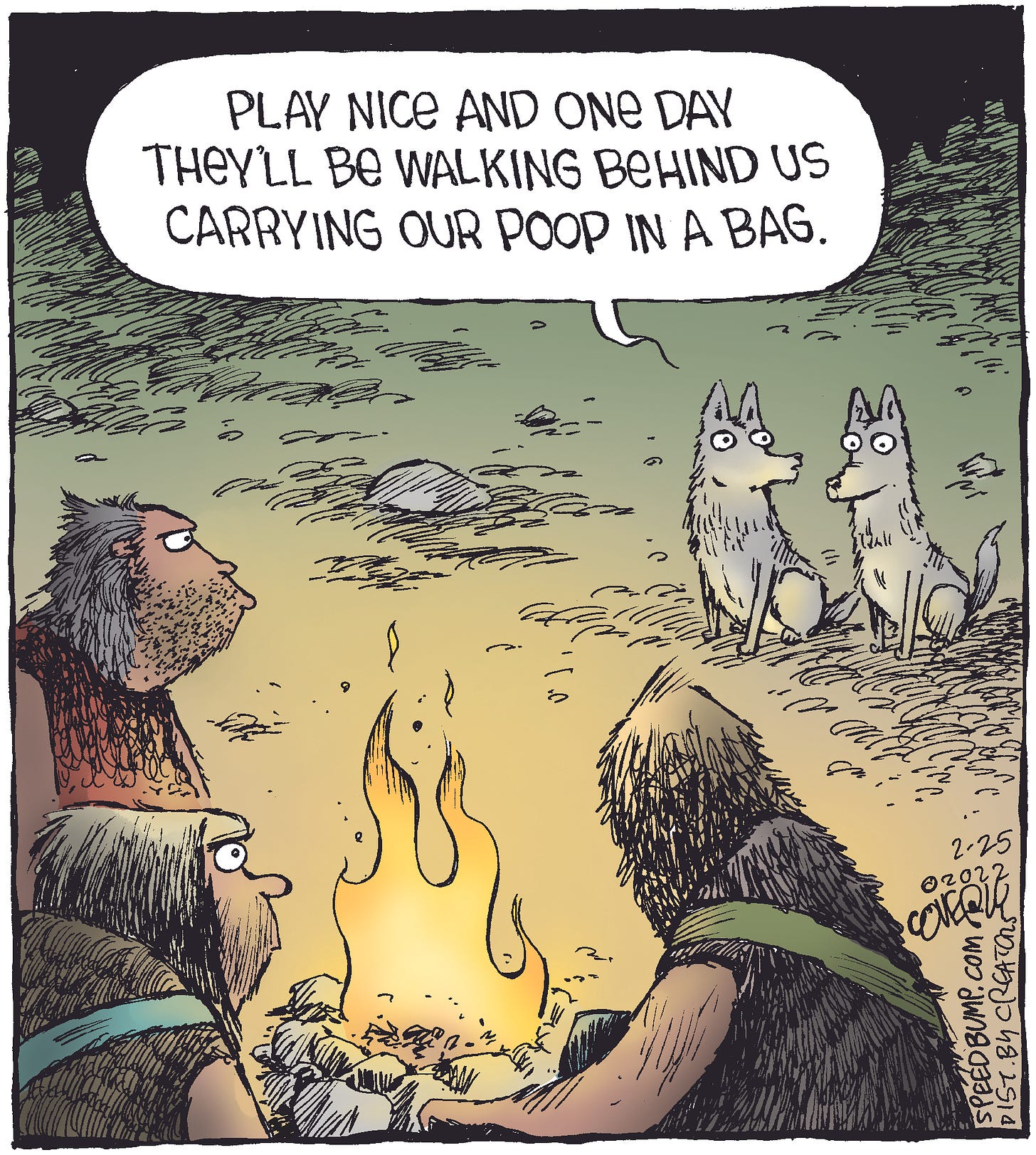July 28: Celebrating the Anthro-Canine Alliance
(Reprinted with permission from the author)
Today is July 28, which, according to Timefulism’s time-compression algorithm, maps to about 22,000-23,000 years ago. That’s a good guess for when the human-wolf-dog alliance was cemented. A brief history of the alliance is below.
Timefulism’s First YouTube video is here:
The video is missing some important points from the writeup below, but also has some additional points that are not below.
The Bond of Predators: The Story of Wolf Domestication
Chapter 1: Kindred Spirits in the Wild
We celebrate the human-dog partnership on July 28 every year.
In the dawn of human history, when our ancestors roamed the vast, untamed landscapes, they were not alone in their struggle for survival. Another apex predator shared the terrain with them—the wolf. Much like humans, wolves hunted in closely-knit packs, often comprising family or extended family units. This similarity was not just in their hunting techniques but in their social structures as well.
Both wolves and humans were exceptional at cooperative hunting, relying on intricate communication and teamwork to bring down prey much larger and swifter than themselves. Their packs were bonded by strong familial ties, with members caring for the young, the old, and the injured. Both species mated for life, and the elderly were valued for their wisdom and experience, often playing critical roles in teaching the younger generations.
The last common ancestor of dogs and humans lived about 85 million years ago. For most of that time, our ancestors lived separately and apart, evolving along very different paths, and occasionally killing and eating each other. It wasn't until relatively recently, between 22,000 and 23,000 years ago, that these paths converged once again, setting the stage for an unprecedented alliance.
Chapter 2: The First Steps Towards Domestication
The initial interactions between humans and wolves were likely cautious and tentative. Wolves, curious about the strange two-legged creatures and their helpless offspring, started scavenging near human campsites, attracted by the scent of burning meat. Over time, certain wolves, the bold and the curious, began to linger closer to the campfires, gradually losing their fear of humans.
Humans, too, saw potential in these interactions. They noticed that wolves could be useful allies in hunting, their keen senses and speed complementing human ingenuity and strategy. By selectively feeding and protecting the friendlier and more cooperative wolves, humans began the slow process of domestication.
These wolves, now semi-dependent on humans for food, started forming a unique bond with them. They provided early warning of danger, helped in hunting, and even offered companionship during long, cold nights. In return, humans provided protection and a steady supply of food. This mutualistic relationship deepened over generations, with humans and wolves gradually learning to communicate and trust each other.
Chapter 3: Evolution Through Agriculture
As human societies evolved and the advent of agriculture transformed nomadic tribes into settled communities, the role of wolves—now becoming dogs—began to change. The early domesticated dogs adapted to their new environments, evolving alongside their human counterparts.
With the rise of agriculture, humans needed dogs that could guard their homes and livestock, herd animals, and protect crops from pests. This necessity led to the selective breeding of dogs for specific traits. The friendliest, most loyal, and most skilled dogs were chosen for breeding, resulting in a gradual but significant transformation of the species.
The evolution of dogs was not just physical but also behavioral. Dogs developed an uncanny ability to read human emotions and body language, making them incredibly attuned to human feelings. This ability made them even more indispensable to human society. Their roles diversified: some became herders, others guardians, hunters, or companions. This selective breeding accelerated their adaptation, creating the diverse array of breeds we see today.
Chapter 4: Unique and Amusing Breeds
Throughout history, some dog breeds were developed for unique and amusing purposes. For instance, the Dachshund was bred to hunt badgers by chasing them into their burrows. This long, low-to-the-ground breed was perfect for navigating tight underground spaces, showcasing the ingenuity of selective breeding.
As breeds specialized for specific tasks, their physical and behavioral traits became more pronounced. This specialization further solidified the bond between humans and dogs, as each breed fulfilled distinct roles within human society.
Chapter 5: The Modern Bond
The relationship between humans and dogs continued to evolve, becoming one of the most profound interspecies bonds in history. Dogs became integral to human life, providing not only practical assistance but also emotional support and companionship.
In modern times, dogs serve in countless roles: as guide dogs for the visually impaired, therapy dogs for the sick, police and military dogs, and, of course, beloved pets. Their ability to understand and respond to human emotions makes them unique among domesticated animals.
This journey from wild wolves to loyal companions is a testament to the power of cooperation and mutual respect. It is a story of how two apex predators, recognizing their similarities, forged an unbreakable bond that has endured for millennia.
As we look into the eyes of our dogs today, we see not just a pet but a partner in an ancient alliance. The domestication of wolves into dogs is a story of evolution, adaptation, and the enduring strength of a bond formed in the wild, nurtured through the ages, and cherished in the present day.
The secular religion of Timefulism uses an exponential algorithm to map each day of the year to a period in the history of humanity, which is also the history of the universe. We celebrate the domestication of dogs on July 28, because July 28 maps to 22,000 to 23,000 years ago, which is a good estimation of when humans cemented their relationship with wolves and when dogs began to appear.




